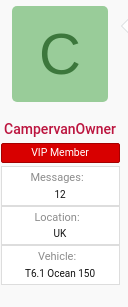C
CampervanOwner
VIP Member
I’ve been trying to educate myself (& struggling) on the battery level of our new 6.1 Ocean.
I’ve seen various versions of the ‘State for Charge’ tables. Does the percentage column correspond in any way to the number of blue highlighted bars on the battery level showing on the console? If so, our console was displaying 11.9v but just 2 blue bars. Isn't 11.9v around a 40% State of Charge (therefore, 4 bars)?
Regardless, we took the van for a drive purely to top up our battery levels (no hook up available). Was this right to do based upon 11.9v (or 2 'bars') or could we have left it longer?
This disappointed me as we’d dropped from 12.8v (9 bars) when we arrived on campsite to 11.9v only 48 hours later. Is this normal as it’s waivered my confidence with trying to go without hook up? I thought we'd last more than 2 days.
Our amp usage (?right word?) waivered between -1a and -4a. We had the fridge on level 3 and only used the lights for maybe an hour both nights. It was quite warm too.
I’d appreciate any guidance (in layman’s terms!). Thank you
I’ve seen various versions of the ‘State for Charge’ tables. Does the percentage column correspond in any way to the number of blue highlighted bars on the battery level showing on the console? If so, our console was displaying 11.9v but just 2 blue bars. Isn't 11.9v around a 40% State of Charge (therefore, 4 bars)?
Regardless, we took the van for a drive purely to top up our battery levels (no hook up available). Was this right to do based upon 11.9v (or 2 'bars') or could we have left it longer?
This disappointed me as we’d dropped from 12.8v (9 bars) when we arrived on campsite to 11.9v only 48 hours later. Is this normal as it’s waivered my confidence with trying to go without hook up? I thought we'd last more than 2 days.
Our amp usage (?right word?) waivered between -1a and -4a. We had the fridge on level 3 and only used the lights for maybe an hour both nights. It was quite warm too.
I’d appreciate any guidance (in layman’s terms!). Thank you

















